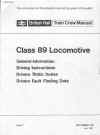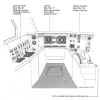




The Brush Class 89 AC electric Co-Co locomotive
| The
Class 89 was a prototype 4350kW (5800 HP) high speed co-co 25kV electric
locomotive which was designed by Brush Electrical Machines Ltd. at
Loughborough and built by B.R.E.L. at Crewe Works.
It was designed for both locomotive-hauled and 'Push-Pull' operation and in the latter mode could be operated remotely from a Driving Van Trailer (DVT) vehicle using a Time Division Multiplex (TDM) system of control by which 'signals' are sent through the standard Railway Clearing House (RCH) lighting jumper cables to operate the controls of the locomotive, or on Mark 4 coaches through specially installed UIC screened cables. Its principal statistics were :
Here is a short pictorial survey of the locomotive's life and times Click on the picture for a bigger image - All photos are from the author's collection |
||||||||||||||||
The Class 89 loco was built at BREL's Crewe Works and was delivered by rail to Derby on Wednesday 2nd October 1986. After arrival at Derby, Litchurch Lane (Carriage & Wagon) Works it was placed on a low loader for transport to Brush's works at Loughborough, which at that time had no rail access. Following extensive static tests and commissioning, in February 1987 the locomotive arrived back at BREL's Litchurch Lane works on a low loader having taken a couple of days to travel from the Brush works at Loughborough. The reason for the journey taking
a couple of days for the short trip was due to a defective axle on the low
loader which occurred at a road junction between Loughborough & Rempstone. After arrival it was moved to the RTC. Here are some pictures of the loco under test and in service. Click on the picture for a bigger image - photos are as credited Following its arrival at the RTC the locomotive was instrumented and carried out a series of acceptance and performance tests both static and dynamic. The track tests were mainly on the West Coast Main Line (WCML) between Carlisle and Crewe, but it did venture south of Crewe on occasion. It was coupled to the DM&EE's Mk3 Test Car No:10 and had a train made up of the BREL 'International' coaches. It was also hooked up to the R&DD's Lab 6 'Prometheus' for its main line pantograph performance tests. The locomotive visited the Old Dalby test track in April 1987 to evaluate its pantograph aerodynamics and was tested at up to 100 mile/h. This was the maximum speed of the class 47 which was used to propel the locomotive. See the aerodynamics page on my Old Dalby site for more details of the pantograph aerodynamic tuning tests undertaken at the test track. It visited the RTC and Old Dalby again in May 1988 when it was part of the IVA88 special train, which was subject to some braking trials, prior to being despatched to Hamburg for the international transport exhibition IVA88 held during that summer. It also carried out some test work on ECML - look here for some pictures of 89001 and surrogate DVT's. Click on the picture for a bigger image - photos are the author's unless otherwise credited |
 |
In March 1987 the locomotive arrived back at BREL's Litchurch Lane works on a low loader having taken a couple of days to travel from the Brush works at Loughborough. Derek Young |
 |
A few hours later the locomotive was back on the tracks and ready for the short journey across to the RTC. Derek Young
|
 |
Another shot of the locomotive showing a then new Class 142 railbus in the background - who'd have thought the railbus would fair better than the loco? Derek Young |
 |
In early April 1987 the loco was at Old Dalby for pantograph aerodynamic tuning tests and is pictured coupled to Lab 6 "Prometheus" just south of the control centre. Author's collection |
 |
Not long after arrival at Old Dalby for these tests the loco was re-called to
Brush's works for an open day where it is pictured.
Derek Young |
 |
As part of the static acceptance
testing the loco was subjected to a bogie rotational test in the Engineering
Development Unit (EDU) workshop. The picture shows the bogie being slewed on
the rotational rig. Author's collection |
 |
Further evaluation included a sway test. The picture shows the class 89 undergoing such a test in the EDU workshop at Derby. This involved jacking the locomotive on one side under strictly controlled conditions and measuring the movement of the locomotive body and hence determine the suspension stiffness. Note the Class 154 prototype in the background Author's collection |
||
 |
Amid the clutter of the workshop 89 001 is pictured coupled to the DM & EE's Test Car 10 whilst being prepared for its main line acceptance testing - probably May 1987. For more details of the various test cars which have been used by the DM&EE over the years look here D Bower |
||
 |
89 001 sits at Carlisle with Test Car 10 and probably a train of the BREL 'International' coaches waiting for a trip back to Crewe sometime in summer 1987. These tests were likely to have been associated with the loco's traction performance over Shap Summit. Author's collection |
||
 |
Here it is heading north at Ledburn Jnc south of Leighton Buzzard on April 28th 1987 Martyn D. Hull |
||
 |
The same train
pictured in the Lakes with
the Research Division's Lab 6
(Prometheus) and Test Car 10 in tow plus a number of the International coaches
whilst undertaking performance tests sometime in the summer of 1987. The
location is the Lune Gorge, south of Shap on the WCML
Peter J Robinson |
||
|
|
The same
train heading south through Bletchley on 28th April 1987
Paul Clarke |
||
 |
The same consist is
seen here heading south at Lancaster in 1987 Paul Rose |
 |
On a test train at
Crewe on 24th June 1987 - note the cables on the front for use when the loco
ran round its train so that it could be re-connected to the instrumentation
and intercom Jeremy Hinks - see his excellent site here |
|
|
Pictured at Elvanfoot on
Beattock bank on 8th October 1987, the loco is undertaking a load test
when it started from a stand and pushed a class 86 plus 6 coaches whilst
also hauling 9 International coaches plus 3 Intercity vehicles.
Tim Harris |
||
|
|
The locomotive undertook
pantograph performance tests on the southern part of the WCML, hauling a train made up of
TC10 and Lab 6 together with six of BREL's
'International' Coaches. Here it is passing Stafford on a test run on 28th April 1987
Most of these coaches ended up in the Republic of Ireland, usually working on the Dublin-Galway route. After some years out of use, they were sold to IE around 1995/96 and overhauled/modified at Inchicore Works, receiving 5ft 3in gauge bogies. Look here for more information Steve Jones |
||
|
|
89001 undergoing
test runs .Weaver Jn
.Alex Lawson |
|
89001 undergoing
test runs .Weaver Jn
Alex Lawson |
 |
89001 heading south
through Bletchley on test with Lab 6 plus Test Car 10 plus a few
international coaches in tow Frank Cheevers |
 |
At Crewe, probably
on test Unknown |
 |
With engineers in Lab 6 monitoring pantograph performance, the loco heads through Stafford on 28th April 1987 Steve Jones |
 |
The loco passes Welwyn North
station on a driver training run from Hornsey to Peterborough on January
19th 1988 with a rake of Mk1's
Brian Beer |
|
Following the completion of its type testing and driver training, the locomotive was put to work on the 17.25 KX to Peterborough train initially. The author was fortunate to have a cab ride on this train on one occasion and can say that it rode very well and was quiet too. Very impressive after the Class 91. Click on the picture for a bigger image - photos are the author's unless otherwise credited |
 |
In early July 1988 the Class 89 locomotive is pictured at Bounds Green depot prior to working a special to York in connection with the 50th anniversary celebrations of the class A4 Mallard's high speed run in 1938. It has been specially cleaned and the buffers quartered and polished for the occasion. |
 |
And here it is about to depart
from 'The Cross'
Unknown
|
 |
On its first journey in passenger service the loco passes Alexandra Palace station on 15th July 1988 heading the 17.35 KX to Peterborough train. The polished buffer heads are still evidence. |
 |
Waiting to leave the Cross on
the 17.35 to Peterborough David Walsh |
 |
Earlier in the year it was a long way from the ECML. Pictured on May 23rd 1988 the class 89 locomotive is being loaded onto the Nord Pas De Calais train ferry at Dover Western Docks en route for Hamburg - see my IVA_88 page for details and more pictures. | ||
 |
Whilst in service with InterCity it was named 'Avocet' on 16th January 1989 at Sandy, Beds - the home of the RSPB - by the anti-rail PM Margaret Thatcher. Following this it acquired the nickname 'Aardvark' although the gricers used to call it 'The Badger'. It also worked some specials and is seen here at Copley Hill near Leeds with a rake of Pullman coaches. Simon Judd |
||
 |
Here it is at Leeds with an
evening departure for Kings Cross in May 1990. John Armitstead |
 |
The loco is seen here out of service at Hornsey Depot during the summer of 1990 when it was unloved and unused |
|
Once it was fitted with the Time Division Multiplex (TDM) control system, the locomotive was used for a few years alongside the Class 91's on the KX-Leeds services. However following several failures it was stored out of use at BN for a year or so. It was then sold and ended up at the Midland Railway Centre, Butterley, Derbyshire.
Much later, after several abortive attempts to resurrect the loco, it was finally re-furbished for Sea Containers and put back into service on GNER trains in 1996 between KX and Leeds on its familiar stamping ground. It was also re-painted into the GNER blue for the role but lost its name in the process. |
|
In 2000 the loco was
withdrawn following serious traction motor defects and in late 2001 it was transferred to Bombardier's works at Doncaster where it was stored out of
service. 89001 was finally purchased from GNER towards the end of 2006 and has now been re-painted into its original InterCity livery and looks a treat. Rumours in November 2010 suggested that moves were afoot to restore the loco to working order Look here under the 'gallery' link for some pictures. |
 |
89001 pictured at the 'Great Gathering' at Crewe Works on 10th September 2005 Author |
 |
Repainted into its original InterCity livery 89001 is seen at Barrow Hill on 17th May 2008 Author |
See the IVA88 page for more pictures of the Class 89 in foreign climes.